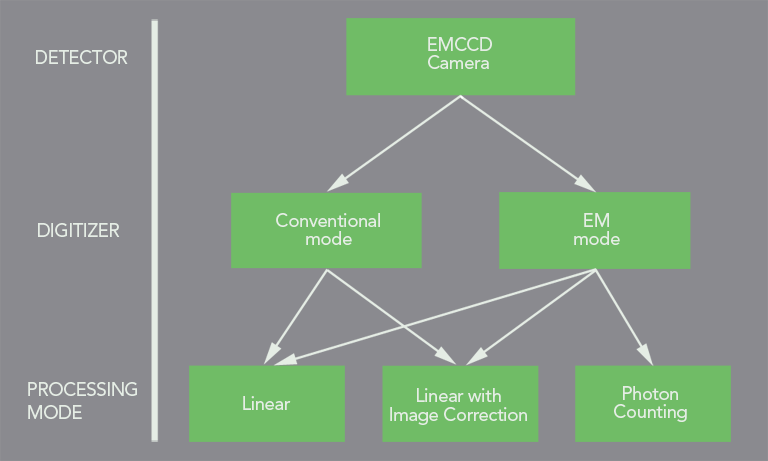
EMCCD Operations
Protected: EMCCD Operations
EMCCD OPERATIONS
Gathering data with an EMCCD camera can be performed in several manners: it includes two different digitizers, one with the electron-multiplication register and one without.

NÜVÜ SUPPORTS ALL OPERATING MODES BELOW
-
CONVENTIONAL MODE
The conventional mode is carried out as if the EMCCD was a CCD detector: photoelectrons are read out pixel per pixel without additional amplification. Such mode is ideal for bright conditions where the overall noise is negligible compared to the input signal.
-
EM MODE
The electron-multiplying (EM) mode ensures that the photoelectron signal is amplified through the EM register before digitization to counteract the readout noise. Such digitizer is preferred for low light imaging where fewer photons are detected. In similar conditions, the conventional mode would yield a readout noise as high or greater than the input signal!
-
PROCESSING OPERATIONS
Each digitizer includes a subset of processing operations. In linear mode (LM), each of the pixel’s intensity reflects the number of photons collected during an exposure. Such mode also comprises an image correction option, the bias, which consists of a series of closed-shutter frames that are combined, and then subtracted from the image, to discard camera-related artifacts. The LM mode supports both conventional and EM linear acquisitions.
Nüvü™ also offers a photon counting (PC) mode for extreme low-light applications, which exclusively operates in EM mode.
MODES OF OPERATION: THEIR STRONG EFFECT ON OVERALL NOISE
Adopting the proper mode of operation of the detector also enhances an EMCCD camera performance.
The inverted mode of operation (IMO) generates a population of holes—the absence of electrons—within the sensor’s silicon substrate. Holes then recombine with dark electrons generated by thermal agitation before readout. As a result, IMO significantly decreases the Thermal noise and is perfectly suited for long acquisitions. However, its trade-off is that the moving holes lead to increasing levels of CIC while electrons shift toward the readout register. By opposition, the non-inverted mode of operation (NIMO) does not induce a population of holes and yields less CIC; it is ideal for short acquisitions where dark current cannot build up.
Nevertheless, finely tuning EMCCD controller signals leads to a significant drop of CIC in the inverted mode of operation. Such is the ability of Nüvü™’s state-of-the-art and patented CCD Controller for Counting Photons (CCCP), exclusively running in IMO. Integrated into all Nüvü™ products, CCCP allows a user to perform both short and long acquisitions at fast readout speeds for exquisite images with outstanding SNRs.
It is worth noting that IMO and NIMO modes are mutually exclusive, and one may lead to better specifications than the other. At Nüvü Camēras, all specification data are acquired in IMO whereas other EMCCD camera manufacturers may provide CIC in NIMO and dark current levels in IMO. Given that both modes are mutually exclusive, the resulting overall noise measured in the lab may be greater than expected when using these manufacturers’ cameras.
WHEN EVERY PHOTON COUNTS
Nüvü Camēras’ imaging sensitivity is based on its innovative CCD Controller for Counting Photons (CCCP) that makes EMCCD devices faster and more accurate in low-light conditions. CCCP’s astonishing clock precision significantly decreases CIC, the major noise source of EMCCD at rapid readout rates.
Nüvü™ imaging devices modernize the fields of Space & Defence and Life Science research: on the one hand, they provide a better understanding of the physical principles behind the stars and galaxies; on the other hand, they detect even the faintest luminous signals emitted by medical diagnostic tools such as fluorescent markers or laser light scattered by in vivo tissues. In turn, these signals may indicate early signs of diseases such as macular degeneration or early stage cancer.